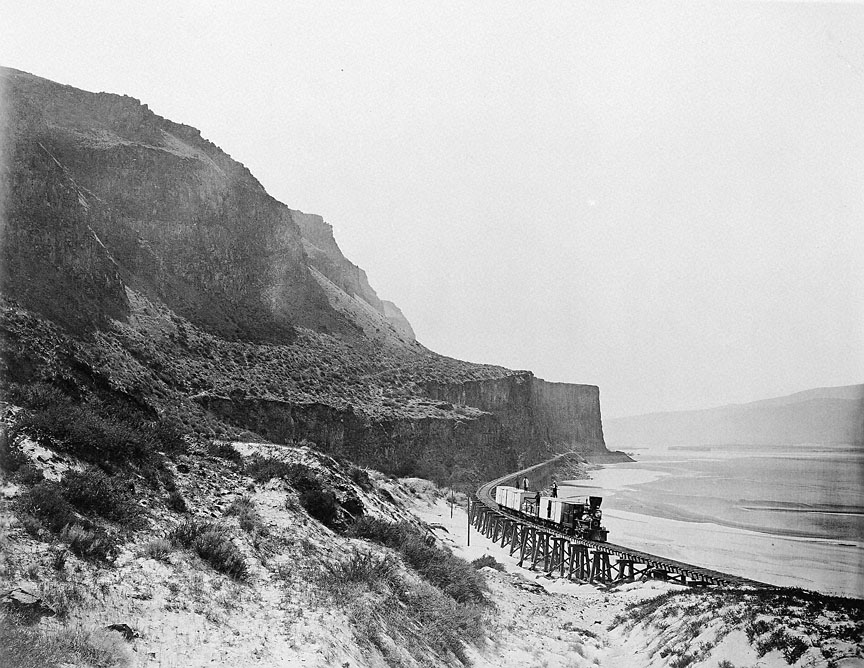- Catalog No. —
- OrHi 21585
- Date —
- 1867
- Era —
- 1846-1880 (Treaties, Civil War, and Immigration)
- Themes —
- Transportation and Communication
- Credits —
- Oregon Historical Society
- Regions —
- Columbia River
- Author —
- C. E. Watkins, photographer
Portage Railroad near Cape Horn
In 1863, the Oregon Steam Navigation Company (OSNC) built a fourteen-mile-long portage railroad eastward from The Dalles around Celilo Falls, a series of several long rapids and eddies with dramatic drops in elevation of forty feet. The Dalles-Celilo portage railroad, one of the first railways in the region, was located on the south bank of the Columbia below rocky cliffs on the sandy edges of river. It passed by the village of Celilo, where Indians had lived and traded with distant people for more than 10,000 years. Native people had valued the rich salmon fishery at Celilo Falls for thousands of years, but Euro American settlers viewed the falls as an obstacle to transportation between Portland and developing markets. Steamboats were used on the Columbia River in the early 1850s, but river travel was uncommon until gold was discovered in eastern Oregon and Idaho in the 1860s. In the 1870s, mining traffic was replaced by shipments of wheat that went through Portland to distant markets, including Europe and Asia.
Several steamboat and portage companies initially competed on the Columbia, but the OSNC, led by captain John C. Ainsworth, soon monopolized shipping on the river. Ainsworth and his partners first negotiated for exclusive use of portages at Celilo Falls and the Cascade Rapids, and eventually the company acquired portage roads at both sites. The success of the OSNC helped establish Portland as the commerce center in the Pacific Northwest. The portage railroad was replaced in the early 20th century by The Dalles-Celilo Canal, a series of locks that allowed boats to travel past the falls safely. In 1957, The Dalles Dam inundated both Celilo Falls and the canal. In 1867, the company may have hired photographer Carleton E. Watkins, now remembered for his superb landscape photography, to document the area's scenery and the Columbia River and Willamette River portage railways.
Further Reading:
Mills, Randall V. Stern-wheelers up the Columbia. Palo Alto, Calif., 1947.
Johansen, Dorothy O. “The Oregon Steam Navigation Company: An Example of Capitalism on the Frontier.” Pacific Historical Review 10, 1941: 179-88.
Written by Kathy Tucker, © Oregon Historical Society, 2002.
